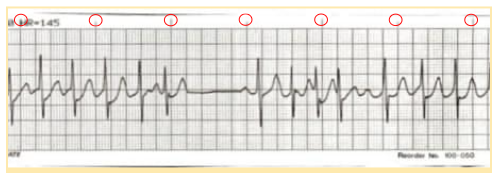Approach to ECG Interpretation – Rate
- Normal heart rate: 60–100 bpm
- Bradycardia: < 60 bpm
- Tachycardia: > 100 bpm
The easiest way to calculate the heart rate when a normal sinus rhythm is present is to count the number of small squares between two R waves. The heart rate is equal to 1,500 divided by the number of small squares between two R waves, as shown in Equation 1 below:
Equation 1. Heart rate calculation during sinus rhythm
Heart rate = 1,500 ÷ sum of small squares between two R waves
A faster but less accurate way to calculate heart rate in a normal sinus rhythm is to count the number of large squares that fall between two R waves. The rate equals 300 divided by the sum of the squares, as shown in Equation 2 below:
Equation 2. Heart rate calculation during sinus rhythm
Heart rate = 300 ÷ sum of large squares between two R waves
If the rhythm is irregular, the heart rate can still be calculated by marking 6 seconds on an ECG strip. The operator does this by counting five large squares (which are equal to 1 second) using a 6-second ECG strip that contains 30 large squares and then counting the number of R waves between the squares. The heart rate is determined by multiplying the R waves within the large squares by 10.
The rhythm strip contains notches such as those shown in Figure 2.10 (below, circled in red). Two consecutive circles contain five large squares between the notches, and these are equal to 1 second. The time between the first circle marker and the last circle marker is equal to 6 seconds.
There are a total of 12 R waves between the first circle and the last circle. Multiplying 12 R waves by 10 equals 120 waves. The heart rate in this ECG strip is approximately 120 bpm. This method can be inaccurate when the rhythm is irregular, as seen in Figure 2.8.
Figure 2.10 ECG Strip with One-Second Markers

ECG Strip with One-Second Markers